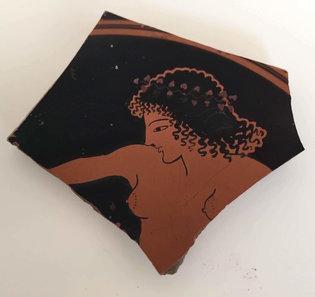Elisabetta Povoledo
Source - http://www.nytimes.com/2015/08/12/arts/design/curiae-veteres-sanctuary-in-rome-attracts-the-curious.html
 Part of a sixth-century cup found in a dig that included the Curiae Veteres in Rome. Credit Courtesy of Antonio Ferrandes
Part of a sixth-century cup found in a dig that included the Curiae Veteres in Rome. Credit Courtesy of Antonio Ferrandes
Archaeologists working on the Palatine Hill here this summer excavated parts of sixth-century foundations connected to a sanctuary of a cult that ancient sources trace back to Romulus, Rome’s mythic founder — a rare find from such an early period.
The discovery, archaeologists say, will probably lead to further exploration for even more ancient elements of the sanctuary, called the Curiae Veteres. The remains came to light during a continuing dig of the northeast slope of the hill. The most recent phase of the dig ended last month.
Excavations in Rome have not recovered much from the sixth century B.C., though the city was already an important center then, said Antonio Ferrandes, deputy director of the dig, which was led by La Sapienza University of Rome. “Our archaeological knowledge is very limited” regarding the period, he said.
The Curiae Veteres was among the most important buildings of that time, a place where Romans assembled to worship, and one of the points that defined the Romulean city. Ancient sources recount the tradition that Romulus, said to have founded Rome in 753 B.C., divided the population into 30 curiae, or neighborhoods, much like today’s boroughs.
Twice a year in Rome’s early years representatives of the 30 curiae gathered in a banquet hall at the Curiae Veteres until the sanctuary became too small and a new assembly place, also called a curia, was built. Scholars say that representatives from four, or seven — the debate continues — curiae continued to meet at the old sanctuary, hence it is described in the plural form.
The sanctuary, believed to have its roots in the eighth century B.C., was destroyed when fire swept through the city in A.D. 64. It was rebuilt a few years later by the Flavian emperors, and was used until the end of the fourth century, when pagan cults were banned.
“This is a building that was used continuously for some 12 centuries,” said Camilla Panella, an archaeology professor at La Sapienza University of Rome who led the excavation, which this year involved 85 students. The university’s archaeologists had already identified the sanctuary as being on the site, but the two-month dig — which ended in late July — was the first time they were able to directly excavate in the archaic portions.
“We’re in a city where buildings have undergone continuous modifications,” Ms. Panella said. One excavated section, reached by descending two rickety ladders and nimbly stepping around a well from the sixth century B.C., proffered traces of a fourth century B.C. sewer, the foundations of a temple restored in the first century A.D. by the emperor Claudius, and pilasters from the second century A.D. during the reign of Septimius Severus.
“This city lives on itself,” she said. “It eats itself.”
Ms. Panella has been excavating the Palatine since 1986. Since 2001 the dig has focused on the slope next to the Colosseum, unearthing some of the earliest structures of the ancient city. Four years ago, the team found the remains of a house they believe to be the birthplace of Rome’s first emperor, Augustus. “We didn’t find a plaque that said so, but we’re pretty certain that this is the place, given that ancient sources say he was born near the Curiae Veteres,” Ms. Panella said.
Now that excavations have ended for the summer, government archaeologists will secure the site and some parts will eventually be accessible to the public.
Ms. Panella hopes to continue excavating the site next year. “There’s still the seventh, eighth, ninth centuries to dig to, as long as we can do so safely,” she said. “Will we get to Romulus?” She added, with a smile, “I’ll tell you next year.”